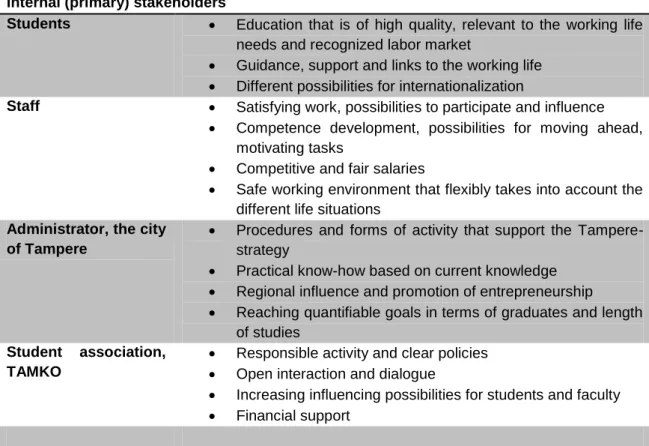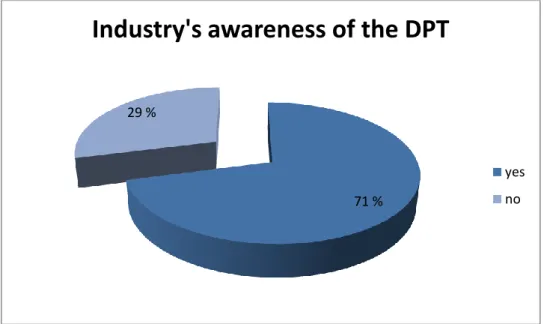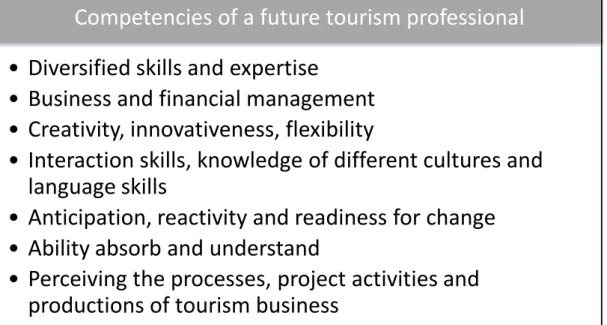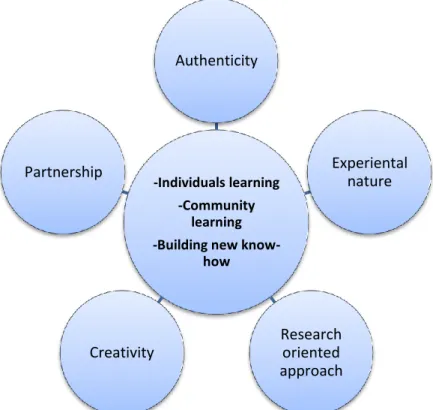FOCUS OF RESEARCH
CONCEPTS AND THEORIES
One of the concepts of the thesis is stakeholders and their interest in the study program. As the current thesis examines the development potential of DPT, the student perspective is focused on the students of the degree program.
RESEARCH QUESTIONS
DATA AND METHODS
The combination of all the data enabled to obtain a holistic view of the subject and to collect new information and perspectives. Inductive analysis technique was implemented in the thesis study as the large amount of data was examined to gain new, concrete understanding of the subject.
CONTENT OF THE RESEARCH
In addition, the results are reflected with the results received from the internal stakeholders and the extensive review of the secondary data. Chapter 3 provides background to the topic of the thesis by introducing TAMK and the DPT focus group to the reader.
TAMPERE UNIVERSITY OF APPLIED SCIENCES
The relationship with TAMK's stakeholders is presented and the work-life relationship of studies is addressed. In addition, the connection of working life with studies is one of the issues examined.
DEGREE PROGRAMME IN TOURISM IN TAMK
CURRICULUM OF DPT, TAMK
The DPT studies prepare the students to be able to work as professionals in the various sectors of tourism. In the third year of study, management and leadership skills are improved and knowledge in the professional studies is increased.

INDUSTRY DEVELOPMENTS EFFECT ON HIGHER EDUCATION
The curriculum must correspond to the competence requirements and expectations of working life and society; provide the latest research information and take into account specific industry developments; and determine the starting level of students.
STAKEHOLDERS OF TAMK
Students High quality education, relevant to the needs of working life and recognized labor market. Industry representatives are interviewed by a questionnaire in order to gain a greater understanding of the demands made by working life.

COMPETENCIES AND QUALIFICATIONS
The latter has awakened discussions about the relationship between education and working life, as the requirements of needed skills and expertise have changed in working life, as well as in the tourism sector. In order to improve the DPT so that it best supports the professional development of students, it must be determined what the skills (qualifications) are that are needed in working life.
COMPETENCIES – THE INDIVIDUAL ATTRIBUTES
GENERIC COMPETENCIES OF THE AMKs
Learning competence - is able to self-assess and develop competence and learning style orientation. Ethical competence - is able to take responsibility for one's actions and for the consequences of these actions.
SUBJECT SPECIFIC COMPETENCIES OF THE AMKs
Innovation competence - is able to carry out research, development and innovation projects by applying existing knowledge and methods of the field. In figure 8 below (continued on page 32), the specific competencies of the study program are presented; fields of knowledge intended to embody future tourism graduates.
QUALIFICATIONS – REQUIREMENTS OF WORKING LIFE
QUALIFICATIONS AND FUTURE FORECAST OF TOURISM INDUSTRY
As the DPT prepares the students to be tourism professionals, working life sets the demands for the future employees. Customer service skills and language skills are essential elements of tourism education at basic level. -Autti states that customer-oriented service and product development as well as marketing and branding are the most important trends in the tourism sector in the future, especially because the industry is constantly internationalising.
Information technology and the development of production and service processes with the help of new technologies will also play a large role in the tourism sector in the future. Internationalization is emphasized in tourism companies in Finland in the future, even more than now, since there are already many multicultural operators in the market area and the clientele is international (Elinkeinoelämän keskusliitto 2005, 47).
QUALIFICATIONS REQUIRED BY TOURISM SECTOR IN FINLAND
In addition, the future requirements (qualifications) of the tourism industry in working life were explained, as it is essential to find out what work in the industry requires, as the DPT prepares students for their future professional life. Thus, we can conclude that the central point in the development of a new curriculum should be the definition of the key competence goals to be achieved in DPT, instead of building a curriculum based on possibly unrelated study modules and subjects. In addition, there is a need to focus on how such competency goals can be achieved and best transferred to students.
Since the courses should be organized so that they meet the requirements of working life (qualifications), it can be assumed that in cooperation with regional business representatives, precise results will be achieved and thus actualize the aspect of regional development. Methods, learning environments and courses must be based around the set goals, not the other way around.
LEARNING ENVIRONMENT IN AMK
LEARNING BY DEVELOPING MODEL OF LAUREA AMK
In the current thesis, other tourism degree programs were compared with the hope of finding new perspectives for the development of TAMK's DPT. The model is part of the pedagogic strategy of Laurea AMK and is applied in various study programs as an operational model. It has been described that the basis for such development-based learning is development projects that are realistically related to the lifespan that aim to renew practices.
The model strives for competence that is expressed in different working methods and thus enables renewal of the labor market, competence and the field of work. Figure 10 on page 37 illustrates the LbD model and the values and goals on which it is based.
LEARNING IN THE LBD MODEL
ROLES IN THE LBD MODEL
Scientific data and theories are used as tools to gain insight into the received empirical data. Given the development prospects of the DPT in TAMK, fully implementing such a model would be a large-scale undertaking. The expertise of students and collaborating partners is formed with a joint effort, giving the students an insight into working life during their studies.
In addition to the contents of the study program and the students' experiences, we checked their expectations, satisfaction and opinions. With the help of the thesis, it is possible to develop the DPT and shed light on its direction and content.
INTERNAL STAKEHOLDERS
THEME INTERVIEW IN GROUPS
Topic 1 is discussed in order to determine the students' expectations, study goals and their motivation for applying to the study program. It delves into the courses and structure of the curriculum; student opinions on course topics and course delivery are covered. The topic gives an idea of the structure of the curriculum; whether the orientation is appropriate and whether it sufficiently covers the industry.
The purpose of theme 3 is to examine the competences and skills learned in the DPT and the students' opinions on how well the study program prepared them for working life. Teaching methods and the implementation of the study program are in focus as well as the relationship between theory and practice.
THE STUDY OF THE INTERNAL STAKEHOLDERS
- THEME 1: GOALS AND OBJECTIVES
- THEME 2: CURRICULUM
- THEME 3: SKILLS AND COMPETENCIES
- THEME 4: METHODS
- THEME 5: GUIDANCE AND INFORMATION
- THEME 6: FUTURE AND CAREER
Many of the students had already worked in the field of tourism and therefore wanted to get more theoretical training and a degree in it. DPT international students said that the problem of finding a placement was in the Finnish language. All students agreed that the application of the subject and the knowledge imparted in the lectures suffered from a lack of sufficient language skills.
The lectures we had could be more effective, as they are an important part of the study. After graduating from DPT, the future and career seemed unclear to most students.
DISCUSSION OF THE INTERVIEW RESULTS
More help from the TAMK was needed to get a clear picture of what the study prepares the students for and to map out careers. To represent the results of the thematic interviews of the students with the descriptions of those competences, certain congruences can be found. Learning competence was achieved when the students mentioned the skill of working in teams and the ability of self-assessment as something they wished they had more.
Internationalization competence is well achieved: the students are able to work in a multicultural environment and they have a command in intercultural communication. Since the DPT is Bachelor's level education, the skills offered must be acquired and covered during the studies, as the students will be the future professionals in working life.
LABOR MARKET REPRESENTATIVES
- RESPONSES OF THE LABOR MARKET REPRESENTATIVES
- THEME 1: DPT VERSUS INDUSTRY QUALIFICATIONS
- THEME 2: DPT’S APPROACH TO BUILDING COMPETENCE
- THEME 3: DPT’S WORKING LIFE CONNECTION
However, the latter does not invalidate the value of the answers in the context of the current thesis. On this note, the responses indicate that DPT succeeds in the latter, in the orientation context. Thus, it can be concluded that the skills shown by industry representatives should be taken into account in curriculum development.
The picture on page 70 shows the interest of labor market representatives in cooperation with DPT (picture 13). Nevertheless, it can be assumed that increased marketing and cooperation with industry would raise the profile of DPT in the labor market.

REPRESENTING TOURISM INDUSTRY OPERATORS: ÉLITE INTERVIEW
THE RESPONSES OF THE ELITE INTERVIEW
COMPARING THE INTERVIEW RESULTS
Competency goals of the DPT and its courses should be better reflected in the studies. The demand for knowledge of the Russian markets could also be included in the training of the DPT. The authors of the thesis conclude that DPT can be developed in a mutually beneficial way.
Such an aspect should be taken into account in the description of the education, courses and guidance. The results of the thesis will be used in the development of the new curricula.
PERSPECTIVE OF THE INTERNAL STAKEHOLDERS
PERSPECTIVE OF THE EXTERNAL STAKEHOLDERS
MUTUALLY BENEFICIAL DEVELOPMENT
We suggest organizing seminars and workshops where industry meets DPT students. The elements necessary for the competence development process represented by the theory of the learning-by-development model exist; therefore, some level of customization could be introduced in the DPT. The views of both groups of stakeholders are consistent with regard to important areas of competence, which is why such competences could be more emphasized in the DPT.
Thereby, the DPT will increase the chances of the students' employability and provide experts based on current needs for the industry. In addition, it can be assumed that increased career and study guidance, as well as dialogue with the labor market, increases students' possibilities of finding appropriate practical training placements and ultimately employment.
IDEAS ON THE CURRICULUM
Moreover, the awareness of the opportunities that TAMK offers to its students should be brought closer to the attention of students in the early stages of their studies. The writers would like to particularly emphasize the importance of making students aware of the opportunities of the R&D department. We are doing our thesis on developing the degree program from a multi-stakeholder perspective, in collaboration with TAMK's Research and Development Services.
We would like to interview you, as a representative of external stakeholders, regarding our thesis. Your answers will provide us with valuable information for our thesis and for the development of future curricula.






